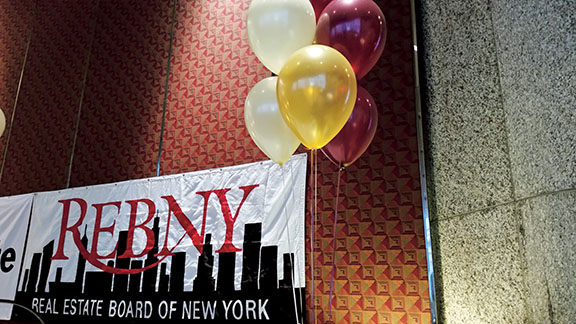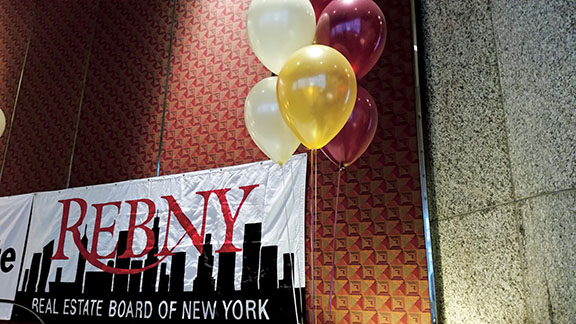A Year in the Life of REBNY
By Tobias Salinger January 14, 2015 3:30 pm
reprints

The Real Estate Board of New York helped property owners with their tax bills and assisted little leaguers with their balls and strikes in 2014.
This past year, the REBNY helped create new construction requirements that now govern mechanics, plumbing and building at every construction site in New York City. The organization worked to negotiate new agreements with both residential and commercial building worker unions representing tens of thousands of employees. REBNY also successfully pushed for a change in expense reporting for city tax purposes, which gives up to 90 percent of affected property owners a break.
And the influential trade and advocacy organization sponsored a Harlem Little League team called the REBNY Rascals.
It’s all in a year’s work for an organization that reached a record high of 16,000 members in 2014, according to REBNY’s recently released annual report. The high-profile trade group often grabs headlines for its work representing the industry’s interests in city and state elections and talks with local government officials, but the 34-page report highlights aspects of REBNY’s activities—both within the public sector and outside of it—that don’t always show up in stories about the 119-year-old organization that’s holding its annual banquet this week.
For example, REBNY’s philanthropy efforts in Harlem assumed greater significance after eight New Yorkers lost their lives in a tragic explosion in East Harlem. Its participation in discussions around new building worker contracts with 32BJ SEIU and IUOE Local 94 helped bring labor certainty for the new year to existing properties all over the city, while its engagement with the rule-making process for construction and crane safety standards in the wake of dangerous and costly construction incidents aided in comprehensive protections for the city’s next generation of buildings. And the group that’s still led by President Steven Spinola achieved a less-heralded but still significant victory when officials with the city’s Department of Finance agreed to make a tax change that REBNY members had advocated.
REBNY carries some sway as the standard bearer of an industry responsible for more than half a million jobs and over $15 billion in annual tax revenues. The past year saw the organization embrace that status anew.
“In 2014, New York City’s future only became brighter,” the report begins. “As a result, it was another good year for real estate.”
Like Oil to Texas
The buildings that mark the city’s landscape comprise only the most visible aspect of the industry’s impact. The city’s real estate sector generated approximately $106 billion in total economic output in 2012, or about 13 percent of the gross city product, according to a report by AKRF that REBNY commissioned and released in March of last year and referenced in the annual report.
The real estate industry paid $15.4 billion in taxes in 2012—or roughly 38 percent of taxes collected by the city. That sum adds up to a higher total than personal income and sales tax revenue combined, and it would pay the salary of all the city’s police officers, firefighters, sanitation workers and correction officers with $2.3 billion left over, REBNY’s annual report notes.
The employees who do work on the industry’s payroll or get jobs through real estate industry business numbered 519,000 in 2012—about 11 percent of the city’s jobs. The industry supported wages totaling $33 billion at an average salary of $61,430 per year, according to the AKRF report entitled, “The Invisible Engine.”
Such numbers showcase the industry’s role in the city’s economy, said Kathryn Wylde, the president of the business organization the Partnership for New York City.
“New York City enjoys a particularly robust partnership between the corporate and financial sectors and the real estate industry,” Ms. Wylde told Commercial Observer. “What has made New York the global center of commerce is a close working relationship where real estate owners are really full partners in the strategic planning of the built environment and also extremely helpful with respect to what’s going on and what are state-of-the-art practices in terms of facilities, spaces and services.”
Coping With the Tragedy in East Harlem
Yet the industry last year showed itself to be about more than jobs and business. Providing a team for the sponsor-driven Harlem Little League shows REBNY’s everyday commitment to philanthropic endeavors, and the organization’s membership stepped up in an emergency situation after an explosion and fire rocked East Harlem. The blast and the subsequent flames started in the morning of March 12 at two five-story apartment buildings on the west side of Park Avenue between East 116th and East 117th Streets, according to an examination of the incident by the National Transportation Safety Board. Recovery work at the site lasted more than six days as first responders suppressed the flames then sorted through the rubble for survivors, the federal investigators said.
But the explosion killed eight New Yorkers and wounded over four dozen others, and REBNY stepped up to address the displacement of the many families living at the two buildings. Members of the organization teamed up with the New York State Association for Affordable Housing to provide 39 temporary apartments for residents who lost their homes that day. The Durst Organization, Glenwood Management, Sidney Fetner Associates, Stahl Real Estate and Urban American helped the victims find both short-term and long-term housing solutions and REBNY itself gave over $100,000 to a victims’ assistance pool from the Mayor’s Fund to Advance New York City, the organization’s annual report says.
“By tapping into the resources of NYSAFAH and REBNY members, we helped coordinate safe and reliable immediate and permanent housing to allow victims and their families to begin the healing process,” said Jolie Milstein, the president of NYSAFAH, in a prepared statement. “In this time of need, we were glad to work together with REBNY and our partners in government to lend support to the victims and give back to the city in which we work and build.”
Warning: Hard Hat Area
Even as they stepped up in the case of an exceptional circumstance, REBNY members worked with city officials and construction industry stakeholders to make the building process safer all over the city. The organization worked in collaboration with a group of 350 interested parties to revise the city’s construction codes, according to the REBNY report. The new standards, which went into effect on Dec. 31, 2014, bring the city in line with laws the City Council passed after Superstorm Sandy as well as with recent changes to the International Building Code and the comprehensive analyses of the terrorist attacks on the World Trade Center by federal officials at the National Institute of Standards and Technology, the REBNY report says. REBNY members worked closely with Mayor Bill de Blasio and First Deputy Mayor Anthony Shorris on the rules, providing input to make them more manageable and practical for the industry.
The City Council passed 13 different laws relating to the codes, according to the city Department of Buildings, and a 355-page overview posted on the agency’s website details the differences between the 2014 codes and the 2008 standards.
REBNY also worked with city officials and other stakeholders to change licensing requirements for all crane operators in the city. The massive machines that help build the city’s skyscrapers represent an integral aspect of all large-scale developments, but they’ve also sparked no shortage of litigation and scary situations such as the dangling crane that snapped 70 stories above West 57th Street on the future site of One57 as Sandy approached the city in 2012. New applicants to operate the essential construction equipment will need to get certification from the National Commission for the Certification of Crane Operators or organizations accredited by either the National Commission for Certifying Agencies or the American National Standards Institute under new laws slated to take effect early this year.
The changes are “enhanced site safeguarding regulations that promote the safety of those that live, work and build in New York City,” a spokesman for the Department of Buildings said. “The rules have been designed through a collaborative process working with industry stakeholders, subject matter experts and other interested parties.”
Death and Taxes
REBNY worked with a different city agency to make a tax change in the past year that will bring relief to property owners in 2015.
In a little-noticed but significant change, officials with the city Department of Finance agreed to a tweak that will allow owners to account for certain operating expenses at their buildings that previously didn’t detract from the properties’ taxable value. After roughly two years of negotiations, REBNY won a change in income reporting laws that will allow commercial and residential rental owners to list amortized capital improvements on their income and expense submission, according to the annual report. Agency officials also granted a raise in the city’s reporting cap on leasing commission payments to $4.60 per square foot from $2 per square foot and tenant improvements to $5.65 per square foot from $3 per square foot, the report says.
That change will lower taxes for 90 percent of such properties and the overall adjustments could carry a full impact of $1 or $2 per square foot less for owners’ tax bills with the city, said Michael Slattery, REBNY’s senior vice president for research.
“The value was really inflated because it wasn’t reflecting all the expenses at the property,” Mr. Slattery said. “For us, the important thing is that it’s now recognizing those expenses. That should have some beneficial effects for owners.”
Real Estate Wonkery
But REBNY’s influence on city, state and federal issues doesn’t always evade the headlines. The organization participated in crafting the de Blasio administration’s plan to create or preserve 200,000 units of affordable housing throughout the city over the next decade, according to the annual report. The framework, which is priced at $41 billion, includes REBNY recommendations such as “increasing density where appropriate, expediting the environmental review, expanding inclusionary housing and preserving existing affordable housing,” the report says.
And the housing plan exemplifies just one looming state-level issue out of several that industry observers will be watching, as much of the ambitious proposal will require Albany legislation for implementation. While the REBNY-backed Jobs for New York political action committee helped Republicans maintain control of the State Senate, according to political watchers, Democrats kept their majority in the State Assembly—a mixture that will complicate several legislative tussles in 2015. The mayor’s housing plan, the state Brownfield Cleanup Program and expiring rules about the 421-a affordable housing credit and the city’s rent regulation program will pose significant impacts on the city’s real estate market, said REBNY’s outgoing president, Steven Spinola. And the industry’s stance on rent regulation hasn’t changed from the last time the program came up for review, he told CO.
“It should be a program that, over a long period of time, would be phasing out rent regulation,” Mr. Spinola said. “We think the current law has some unfair rules and practices. On the other hand, we understand it will be negotiations and a give and take.”
Labor Pangs
REBNY members certainly have understood the give-and-take sentiment in their dealings with the city’s labor unions. Last year (and the early days of 2015) brought resolution to a pair of significant contracts between the Realty Advisory Board of Labor Relations, the body that represents the city’s landlords and property managers where many REBNY members serve as organization directors, and the Local 94 IUOE and 32BJ SEIU unions.
The April 2014 agreement with 32BJ SEIU, which covers 30,000 building workers in 3,000 residential rentals, co-ops and condominium properties over the next four years, will net the workers a 2.71 percent annual raise each year over the span of the agreement, according to the annual report. That means average salaries for doormen and porters will rise to $49,402 from $44,389 by the end of the contract in 2018, the report says.
Around 4,000 operating engineers at 500 commercial properties around the city will also enjoy an increase in wages, thanks to a new four-year contract the Realty Advisory Board and Local 94 agreed to just before the end of the year and approved last week. The engineers, who oversee the buildings’ heavy machinery, will get a raise to $78,690 per year from $76,398 per year under the earlier agreement, RAB President Howard Rothschild told CO.
“The typical person in Local 94 and 32BJ tends to be a very hard-working employee respected by management and ownership and well paid,” Mr. Rothschild said. “RAB and REBNY maintain a great relationship with Local 94 and 32BJ and all the other unions that we deal with.”
In other words, the past year played out as yet another eventful one in REBNY’s long and storied history. And the next one should do so as well, the report notes.
“New York has always been a city of change and renewal,” the report says. “We need to ensure New York City keeps growing and rebuilds itself, whether through new developments like on the West Side or ambitiously rebuilding, like in Lower Manhattan, where we are putting back up what was destroyed by 9/11. All of these plans and projects generate more revenue for New York City and help it become a better place to live, work and raise a family.”


